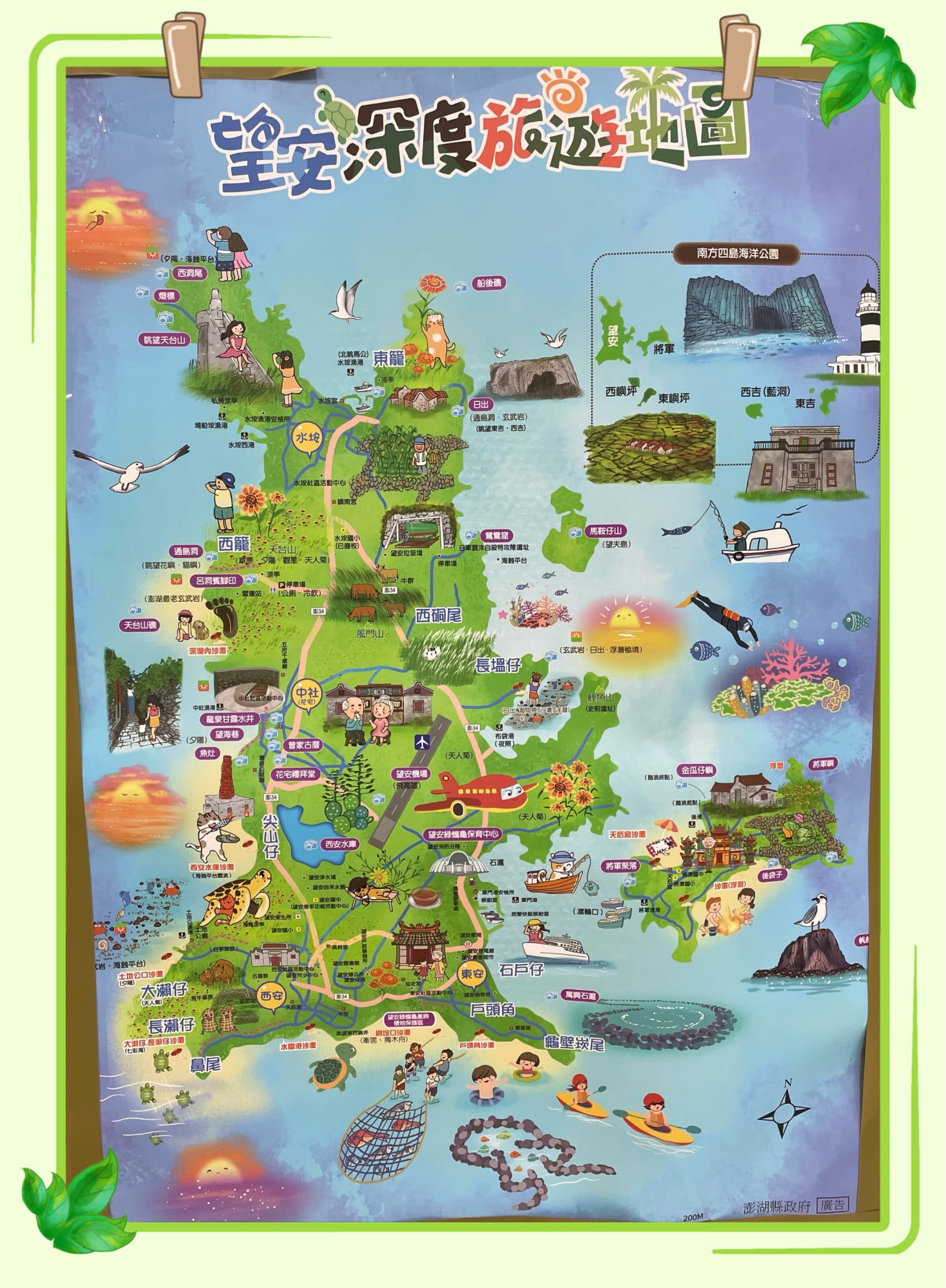- Qimei, Wang’an, Hujing, and Tongpan – See Them All!
- Experience rich scenery and cultural heritage in one comprehensive tour!
- Senior-friendly itinerary with options to ride a scooter or take a tour bus for relaxed sightseeing.
South Sea Four Islands Tour
This tour will take you to the four main islands of the South Sea: "Qimei Island," "Wang'an Island," "Hujing Island," and "Tongpan Island," where you can observe the diverse volcanic rock formations of Penghu. In addition to the stunning scenic views, Penghu has a rich cultural history that predates Taiwan by 403 years, offering a wealth of cultural experiences.
- Gathering Time :07:00 Nan-Hai Visitor Center
- End Time:16:30
- Total Time: 7-8 hrs
- Itinerary:
- 07:20 Depature
- Cimei Island stop around 2 hrs
- Wang-an Island stop around 2hrs
- Hu-jing Island stop around 1 hr
- 16:00 Return
*The schedule might change depending on traffic and weather conditions
🔽Haian Counter, Nanhai vistor Center

- Qimei, Wang’an, and Hujing offer tour bus services. Please inquire for more details.
- Note: Ensure scooter drivers hold a valid Taiwanese license.
- Island-hopping packages, including ferry tickets and scooter rentals, are priced based on pairs (even numbers). For solo travelers or odd-number groups (e.g., 1, 3, 5 people), a single rider surcharge applies for the scooter rental. Groups of even numbers (e.g., 2, 4, 6 people) can book the corresponding quantity without extra charges.
- Due to limited scooter availability, discounted rates are offered for two people sharing one scooter. Solo riders will incur an additional charge.
- Infant tickets: 0-2 years; 3 years and above are charged the same as adults.
- Not recommended for those with mobility issues, high blood pressure, epilepsy, or similar conditions.
- Pets of all sizes are welcome on board but must be seated in outdoor areas.
Must-Visit Attractions
Qimei Island:
Twin-Heart Stone Weir:The “Twin-Heart Stone Weir” is a popular site constructed by local villagers using basalt stones. Its shape, resembling two interconnected hearts, attracts many couples who come here to pledge their eternal love, creating a romantic atmosphere.
Little Taiwan: This is a marine erosion platform located on the inner side of Niumping Bay on Qimei Island. It is called “Little Taiwan” because its shape resembles that of Taiwan Island. This geological wonder was formed by years of sea erosion and only emerges during low tide. Visitors are advised to check the daily tide schedule (it is recommended to visit during low tide to witness the moment when the “water recedes and the rocks emerge”).
Great Lion and Dragon Well:On this basalt coastline, looking to the left and right, one can see a lion and a dragon guarding the area. The “Great Lion” is a rock protruding from the sea cliff, shaped by marine erosion to resemble the head, neck, and even the body of a lion, standing guard over the ocean. On the left, the rock veins extend into the sea like a coiled dragon, hence the name “Dragon Well.” Some say it resembles an eagle’s head, with the viewing platform representing its wings. What animal does it resemble to you? Come and see for yourself.

Must-Visit Attractions
Wang’an Island:
1. Tiantai Mountain: Also known as “Honeymoon Island,” it stands 53 meters above sea level. The west side features a natural bay, and from the summit, you can enjoy breathtaking views. The mountain has a natural pasture and is the island’s top attraction. Legend says that the “Immortal Footprint” on the mountain was left by Lü Dongbin during his visit.
2. Zhongshe Ancient Residences: Originally called Huazhai, these well-preserved traditional Penghu collective residences were renamed Zhongshe Village after the war. The architecture features a Sanheyuan layout (a three-section compound), offering a unique glimpse into traditional settlement architecture.
3. Huazhai Longquan Ganlu Well: Located in the square in front of Shengmu Temple, visitors can draw cool spring water from this well. The fresh water comes from underground sources on the hillside, while seawater flows in a nearby ditch, separated by just a narrow line—a truly astonishing sight.
4. Huazhai Wanghaixiang:”Wanghaixiang” is situated between two traditional houses built with coral stones. Walking through the quiet, narrow alley between the weathered walls and dense foliage brings a nostalgic, vintage atmosphere. At the end of the alley, you’ll be greeted by the vast ocean, which gives this spot its name.
Hujing Island Introduction:
Hujing Island is one of the smaller islands in the Penghu archipelago, located southwest of the main island. It is the seventh-largest island in Penghu, featuring spectacular columnar basalt formations. Due to its proximity to Magong and its strategic location along an excellent maritime route, it was historically a battleground where government troops fought against foreign invaders and pirates. It was also once the most productive fishing ground. However, with the depletion of resources, residents have relocated, leading to the decline of local industries. Today, Hujing Island hosts only one legal homestay, one restaurant, and one elementary school.
The island, rich in history and mystery, was once celebrated as one of the eight scenic spots of Penghu, known as “Hujing Shenyan” (Hujing’s Sunken Abyss). There is a legend of a mysterious sunken city beneath the sea near the island, adding to its allure. Some refer to it as the “Lost Atlantis.” Additionally, Hujing Island was rumored to house a Japanese southern advance command post.
In recent years, due to the numerous adorable cats living on the island, it has also been affectionately called “Cat Island.” The legend of a collapsed city wall hidden at the bottom of the Hujing waters enhances its mystique, making it a fascinating destination for visitors.














